Gardeners and tree lovers appreciate the beauty and importance of red bud trees. They add color and life to our gardens with their spring flowers and leaves. But, like all living things, red bud trees face diseases that can harm them.
This guide will cover the common diseases of red bud trees. We’ll look at symptoms, causes, and how to prevent and manage them. Knowing this helps us protect these trees and keep them healthy for years.
Key Takeaways
- Red bud trees face many diseases, including fungal, bacterial, and viral ones.
- Spotting disease symptoms early is key to treating and preventing them.
- Stress from drought, too much water, or bad soil makes trees more likely to get sick.
- Keeping trees healthy with the right care can lower disease risk.
- When diseases are serious, getting help from a tree expert might be needed.
Overview of Red Bud Trees and Their Importance
Introduction to Red Bud Trees
The Eastern Redbud, or Cercis canadensis, is a small native tree. It’s loved for its bright spring blooms and heart-shaped leaves. These trees grow well in zones 4 to 9, needing well-drained soil and a pH of 4.5 to 7.5.
They can grow up to 30 feet tall and 35 feet wide. This makes them great for many landscapes, both natural and urban.
Ecological Significance of Red Buds
Cercis canadensis trees are more than pretty. They’re crucial for the ecosystem. Their flowers are a first food source for pollinators.
Their leaves and seeds feed and shelter wildlife. As native trees, they help keep biodiversity high. They’re also good for urban and home landscapes because they grow at a moderate pace.
| Characteristic | Description |
|---|---|
| Mature Height | 20 to 30 feet |
| Mature Width | 15 to 35 feet |
| Growth Rate | Moderate, 7 to 10 feet in 5-6 years |
| Lifespan | Typically 20 years, often declining from disease |
| Flower Characteristics | Showy, appearing in clusters, 2-3 weeks in early spring |
| Fruit | Long, flat pods of about 3 inches, produced in late summer and fall |
“Redbuds are a true harbinger of spring, their vibrant pink blooms a welcome sight after the long winter months.”
Common Diseases Affecting Red Bud Trees
Red bud trees are loved for their beauty but face many diseases. Cercospora leaf spot, verticillium wilt, and canker diseases are major threats. These can harm the tree if not treated, so it’s key to know the signs and take action.
Overview of Key Diseases
Canker diseases, like Botryosphaeria, are a big problem for red bud trees. They infect the main limbs and trunk, stopping nutrients and causing branches to die. Drought and open wounds make trees more likely to get cankers.
Verticillium wilt also harms red bud trees, showing signs like cankers. It starts with one limb dying, then can spread to the whole tree if not treated.
Red bud trees also get leaf spot fungi, like anthracnose, in wet springs. These fungi make leaves turn color and fall early, hurting the tree’s health and look.
Seasonal Patterns of Diseases
Diseases like cercospora leaf spot and anthracnose do well in spring’s cool, wet weather. But, summer drought can make canker diseases and Verticillium wilt worse.
Knowing when diseases hit helps tree care professionals and homeowners. They can then take steps to keep their trees healthy and looking good for years.
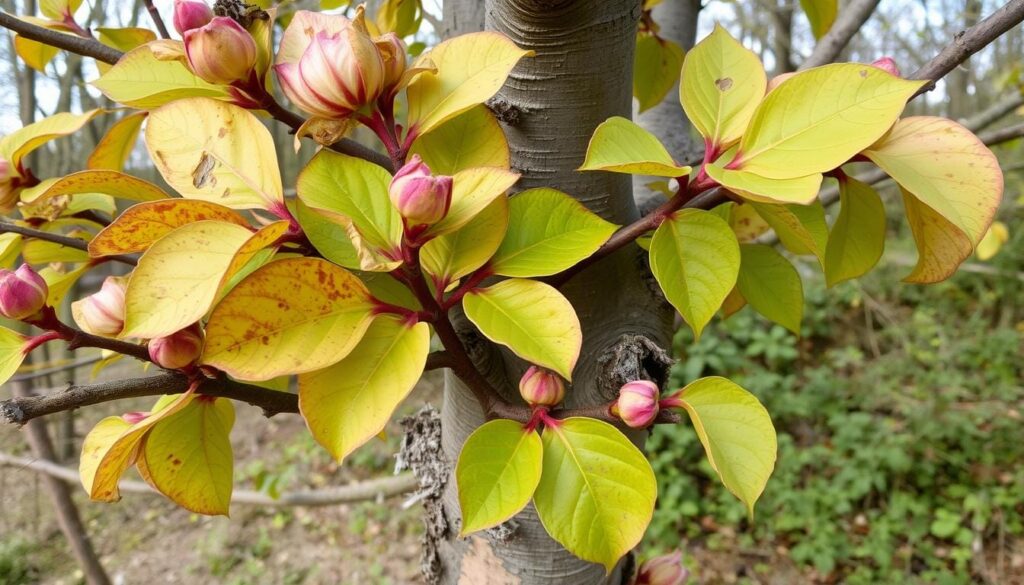
Fungal Infections in Red Bud Trees
Redbuds can get sick from many fungal infections. These diseases can harm the health and life of these lovely trees. The main problems are Botryosphaeria canker, Verticillium wilt, and leaf spot diseases.
Types of Fungal Infections
Botryosphaeria canker is a big problem for redbud trees. It’s caused by the fungus Botryosphaeria dothidia. This fungus can hurt over 50 tree types. It gets into the tree through wounds or when the tree is stressed, like during drought.
It blocks the water supply, causing branches or trunks to wilt and die quickly.
Verticillium wilt is another serious disease. It’s caused by fungi like Verticillium dahliae or V. albo-atrum. It stops water and nutrients from reaching leaves and branches.
This makes leaves turn yellow and brown. It can kill the tree slowly over years.
Redbud trees also get leaf spot diseases. These are caused by fungi like Phyllosticta, Cercospora, and Gloeosporium. They make leaves die in spots, leading to early leaf fall.
But, these diseases usually don’t hurt the tree too much.
How to Identify Fungal Diseases
To spot fungal diseases in redbud trees, look for signs like wilting and color changes. You might also see cankers or lesions on branches and trunks. For a sure diagnosis, see a certified arborist.
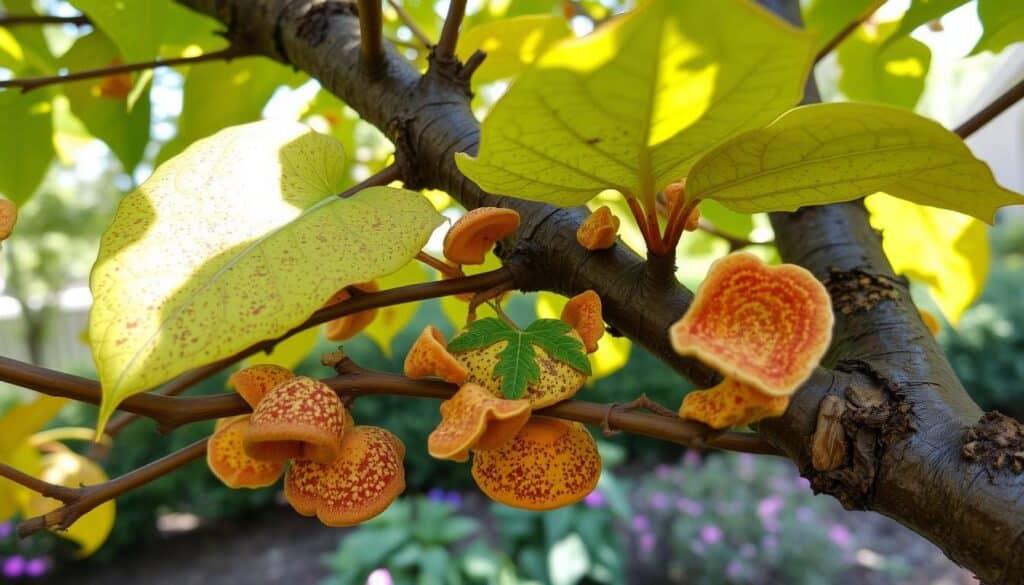
“Consulting a certified arborist for tree assessment and advice is recommended, as they can provide valuable information on tree health and management.”
Bacterial Diseases that Affect Red Buds
Redbuds are loved for their bright flowers and special leaves. But, they can get sick from different bacterial diseases. These diseases include bacterial leaf scorch, crown gall, and bacterial wetwood.
Overview of Bacterial Infections
Bacterial diseases in redbuds are caused by harmful bacteria. These bacteria can get into the tree’s system, stopping it from getting the nutrients and water it needs. These infections show up in different ways, so it’s important to spot them early and treat them right.
Symptoms of Bacterial Diseases
- Bacterial leaf scorch makes leaves turn brown from the edges, then fall off too soon.
- Crown gall shows up as growths on the roots and lower stems of the tree.
- Bacterial wetwood causes sap to ooze from the trunk, looking and smelling bad, and makes the tree sick.
It’s key to know the signs of these bacterial diseases. Treating them is different from how you handle fungal infections. Talking to a certified arborist or plant health expert can help you get the right treatment for your redbud trees.
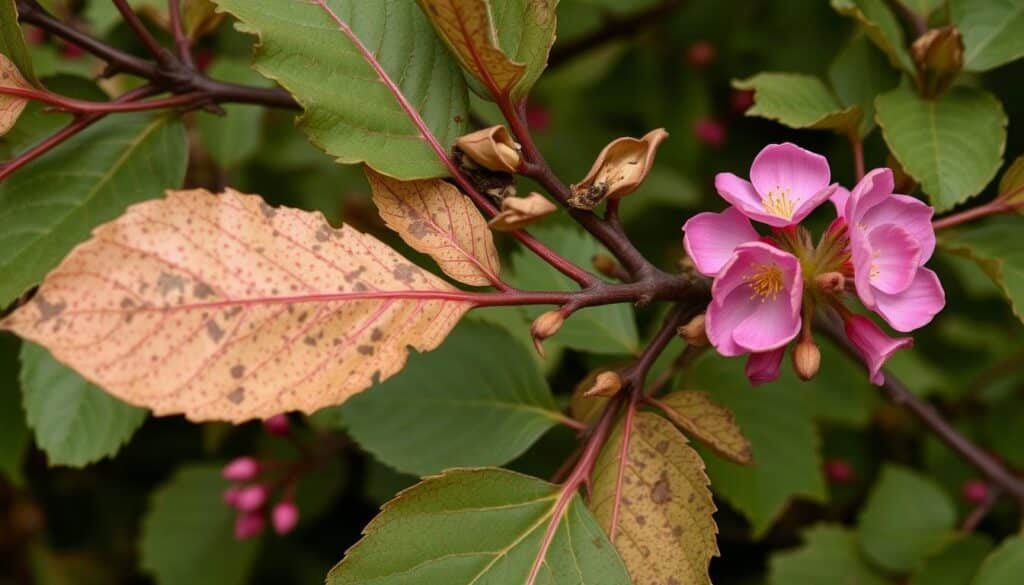
Viral Diseases Impacting Red Bud Trees
Viral diseases in red bud trees are not as common as other issues. But, they can still harm these beautiful trees. It’s important to know about common viral pathogens and their symptoms to manage diseases effectively.
Common Viral Diseases
Two main viral diseases affecting red bud trees are the mosaic virus and the ringspot virus. These viruses can cause leaf mottling, distortion, and stunted growth.
- The mosaic virus creates irregular patterns on leaves, making them look mottled.
- The ringspot virus causes circular patterns or rings on leaves, indicating its presence.
Identification and Symptoms
Spotting viral diseases in red bud trees can be tricky. Symptoms might look like other problems, like nutrient deficiencies or stress. To confirm a viral disease, lab tests are usually needed.
Common signs of viral diseases in red bud trees include:
- Leaf mottling or discoloration
- Leaf distortion or curling
- Stunted growth or less foliage
- Tree looks less healthy overall
Unfortunately, there’s no cure for viral infections in trees. The best way to manage the disease is to prevent and control the spread of disease vectors, like insects.
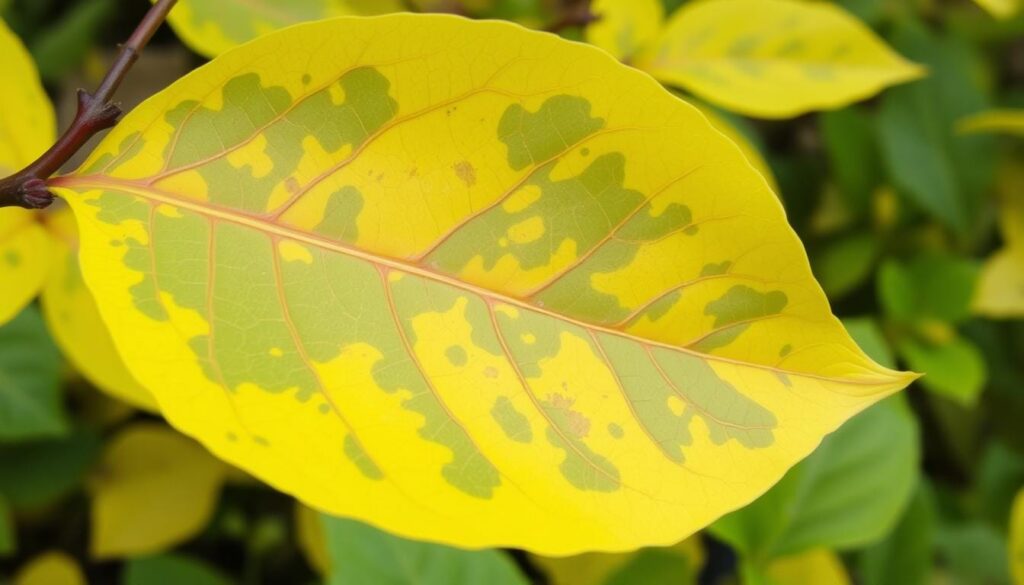
“Viral diseases can be challenging to identify, as their symptoms may mimic other tree health issues. Accurate diagnosis is key to implementing the right management strategies.”
Environmental Stressors and Their Effects
Eastern Redbud trees are quite resilient, but they can still face challenges from environmental stressors. These factors can affect their health and make them more prone to diseases.
Impact of Drought and Waterlogging
Drought can weaken Redbud trees, making them more susceptible to diseases like Botryosphaeria canker. On the other hand, too much water can cause root rot and other fungal infections. It’s important to keep the soil moist but not too wet to help these trees stay healthy.
Role of Soil Quality in Disease
The soil quality is key for Redbud trees’ health. Poor drainage or a lack of nutrients in the soil can stress the trees and make them more likely to get sick. Redbuds do best in well-drained, slightly acidic to neutral soil. Keeping the soil in the right condition is vital for preventing and managing diseases.
| Environmental Stressor | Impact on Redbud Trees | Mitigation Strategies |
|---|---|---|
| Drought | Increased vulnerability to Botryosphaeria canker and other diseases | Consistent irrigation to maintain soil moisture levels |
| Waterlogging | Root rot and other fungal infections | Improving soil drainage and avoiding overwatering |
| Nutrient Deficiencies | Increased environmental stress and disease susceptibility | Proper fertilization and soil management |
Understanding the effects of environmental stressors and keeping the soil in good condition can help protect our Eastern Redbud trees. This way, we can keep them healthy and thriving for a long time.
Recognizing Symptoms of Tree Diseases
It’s vital to spot and treat disease symptoms in our Redbud trees to keep them healthy. Knowing the signs of disease helps us protect these beautiful trees.
Leaf Discoloration and Wilting
Leaf discoloration is a key sign of disease in Redbud trees. You might see spots, yellow leaves, or leaves falling early. Verticillium wilt, a fungal disease, causes leaves to wilt and turn yellow.
Spotting these symptoms early is key to managing the disease.
Bark and Stem Issues
Looking at the bark and stems of Redbud trees can show disease signs. Bark cankers and Botryosphaeria dieback are signs of fungal infections. Branch dieback means some branches die while others stay healthy.
Watching for these signs and acting fast is crucial for our Redbud trees’ health. By knowing the common diseases, we can protect these trees in our cities and suburbs.
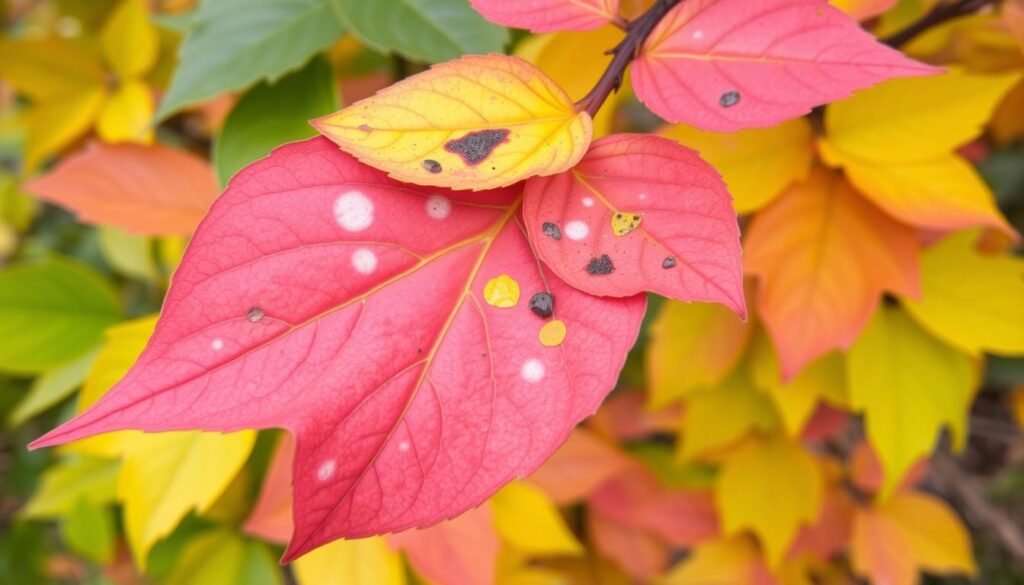
“Certified Arborists can conduct on-site assessments and provide expert advice on treating and managing tree diseases, ensuring tree health and longevity.”
Preventative Measures for Red Bud Trees
Keeping our red bud trees healthy and vibrant is key. We must take steps to protect them from diseases and stress. Regular care and choosing resistant trees are crucial.
Importance of Regular Maintenance
Proper pruning is vital to prevent disease. We should remove dead or damaged branches. This improves air flow and stops fungal infections.
Also, dealing with pests like aphids and scale insects is important. It stops the spread of diseases.
Good growing conditions are also essential. Proper watering, fertilizing, and soil drainage boost tree health. This makes them stronger against stress.
Choosing Disease-Resistant Varieties
Choosing the right red bud trees is important. Trees like ‘Forest Pansy’ and ‘Oklahoma’ resist common diseases well. This choice helps protect our trees for a long time.
Regular checks and quick action are vital. They prevent major disease problems. By being proactive, we keep our trees healthy and beautiful.
“Investing in preventative measures for our red bud trees is a surefire way to ensure their long-term success and the continued enjoyment of their stunning blooms.”
Treatment Options for Diseased Red Bud Trees
We must take care of our urban forests, especially the red bud trees. There are many ways to treat diseases, both natural and chemical. These methods can help our trees get better.
Organic and Chemical Remedies
Liquid copper fungicides are good for fungal leaf spot diseases. They stop the disease from spreading. Fungicides protect the leaves. To fight soil-borne diseases, we need to improve soil health and drainage.
Organic treatments like neem oil or beneficial microbes can also help. For serious infections like Verticillium wilt, a professional arborist is needed. They can give special tree care and advice on keeping trees healthy.
When to Call a Professional Arborist
Some diseases can be treated with organic treatments or fungicides. But, if the problem is severe, like extensive cankers or rapid leaf drop, you need a professional arborist. They can find the problem, suggest the right treatment, and watch over your trees.
“Maintaining the health of our red bud trees is a collaborative effort, and by working with professional arborists, we can ensure these vibrant and ecologically important trees continue to thrive in our communities.”
The Role of Soil Health in Disease Prevention
Keeping our redbud trees healthy is more than just treating diseases. It’s also about preventing them. The health of the soil is key. Good soil fertility and beneficial microbes help our trees fight off diseases and pests.
Improving Soil Nutrients
Redbuds do best in well-drained, loamy soil with a pH of 4.5 to 7.5. Regular soil tests and the right fertilizers ensure our trees get the nutrients they need. This boosts their health and makes them less likely to get sick.
Beneficial Soil Microbes
Mycorrhizal fungi are important for soil health. They work with redbud roots to help absorb nutrients and water. Adding mycorrhizal treatments to our soil care helps our trees stay healthy and strong.
Keeping the soil pH right, ensuring good drainage, and adding organic matter through mulching improve soil health. These steps help our redbud trees stay healthy and prevent diseases.
| Soil Characteristic | Optimal Range for Redbuds |
|---|---|
| pH | 4.5 – 7.5 |
| Drainage | Well-drained, loamy soil |
| Organic Matter | Maintain through mulching |
| Nutrient Balance | Balanced NPK, based on soil test |
| Beneficial Microbes | Establish mycorrhizal fungi |
By focusing on our redbud trees’ soil health, we set them up for success. This approach prevents many diseases and keeps our trees looking great for years.
“Healthy soil is the foundation for healthy plants, and healthy plants are the foundation for healthy people and a healthy planet.”
Case Studies: Diseased Red Bud Trees
Looking at real cases of diseased red bud trees shows us how to manage diseases well. These examples teach us the value of quick diagnosis, fast action, and caring for the whole tree.
Notable Examples
One case was about a red bud tree thought to have Vascular Streak Dieback. But, a pro arborist found it had decay in the main trunk, not the disease. This shows how important it is to check everything carefully.
Another case was about beating Cercospora leaf spot, a common disease. The tree got better thanks to fungicides and better care like pruning and mulching.
Lessons Learned from Each Case
These stories teach us the need for accurate disease diagnosis and caring for trees in many ways. Getting help from experts is key to avoid bad treatments. Also, using a mix of prevention and targeted care can help trees get better and stay healthy.
By studying these examples, we learn more about dealing with red bud tree diseases. Using proactive management and watching trees closely can keep them healthy for a long time.
Conclusion: Protecting Our Red Bud Trees
To keep our red bud trees healthy, we need a full plan. This plan includes knowing common diseases, spotting early signs, and using good prevention and treatment methods. By keeping the trees in the best conditions, checking them often, and acting fast when problems show up, we can lower disease risks. This helps our trees stay strong and beautiful for a long time.
Recap of Key Points
In this article, we looked at the many challenges red bud trees face. These include fungal and bacterial diseases, and problems from drought and poor soil. We also talked about how to spot tree health issues, like color changes in leaves, wilting, and problems with bark or stems. By watching closely and acting early, we can keep our red bud trees safe and healthy.
Encouragement for Tree Care Practices
Good tree care is key to keeping red bud trees healthy. This includes watering right, mulching, and pruning. These actions help stop diseases and keep our trees looking great and helping the environment. Also, getting help from tree experts can be very helpful. Taking care of our red bud not only helps them but also makes our surroundings more lively and green.

